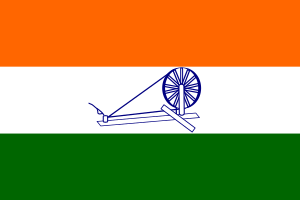علم الهند
- "Indian flag" redirects here. For flags used by Native American people, see the tribes' respective articles, for example the Navajo Nation.
 | |
| India | |
| الاستخدام | علم وطني |
|---|---|
| النـِسـَب | 2:3 |
| اِعتـُمِد | 22 July 1947 |
| التصميم | Horizontal tricolour flag (deep saffron, white, and green). In the centre of the white is a navy blue wheel with 24 spokes |
| صممه | Pingali Venkayya[N 1] |
The national flag of India is a horizontal rectangular tricolour of deep saffron, white and India green; with the Ashoka Chakra, a 24-spoke wheel, in navy blue at its centre. It was adopted in its present form during a meeting of the Constituent Assembly held on 22 July 1947, when it became the official flag of the Dominion of India. The flag was subsequently retained as that of the Republic of India. In India, the term "tricolour" (هندي: तिरंगा, Tirangā) almost always refers to the Indian national flag. The flag is based on the Swaraj flag, a flag of the Indian National Congress designed by Pingali Venkayya.
The flag, by law, is to be made of khadi, a special type of hand-spun cloth of cotton or silk made popular by Mahatma Gandhi.


التصميم والرمزية

Gandhi first proposed a flag to the Indian National Congress in 1921. The flag was designed by Pingali Venkayya, an agriculturist from Machilipatnam.[5][6] The original design Gandhi was presented with included two colours, red for the Hindus, and green for the Muslims. In the centre was a traditional spinning wheel, symbolising Gandhi's goal of making Indians self-reliant by fabricating their own clothing. The design was then modified to include a white stripe in the centre for other religious communities, and provide a background for the spinning wheel. Subsequently, to avoid sectarian associations with the colour scheme, saffron, white and green were chosen for the three bands, representing courage and sacrifice, peace and truth, and faith and chivalry respectively.[7]
Manufacturing process
| Flag size[8] | Length and width in millimetres |
|---|---|
| 1 | 6300 × 4200 |
| 2 | 3600 × 2400 |
| 3 | 2700 × 1800 |
| 4 | 1800 × 1200 |
| 5 | 1350 × 900 |
| 6 | 900 × 600 |
| 7 | 450 × 300 |
| 8 | 225 × 150 |
| 9 | 150 × 100 |
انظر أيضاً
ملاحظات
- ^ The current flag is an adaptation of Venkayya's original design, but he is generally credited as the designer of the flag.
الهامش
- ^ Roy 2006, p. 504
- ^ Roy 2006, p. 505
- ^ India Postage Stamps 1947–1988.(1989) Philately branch, Department of Posts, India.
- ^ Souvenir sheet of the Independence series of stamps, Indian Posts, 1948
- ^ "Finally, Pingali Venkaiah set to get his due". The Times of India. 30 July 2009. Retrieved 11 December 2009.
- ^ "Tribute to the 'flag man'". The Hindu. 10 August 2007. Retrieved 11 December 2009.
- ^ "Flag of India". Encyclopædia Britannica. Encyclopædia Britannica Online. 2009. Retrieved 2 July 2009.
- ^ "Flag Code of India". Ministry of Home Affairs, Government of India. 25 January 2006. Archived from the original on 10 January 2006. Retrieved 11 October 2006.
وصلات خارجية
- "National Flag". National Portal of India. Government of India. Retrieved 8 February 2010.
- "History of Indian Tricolor". National Portal of India. Government of India. Retrieved 2010-08-15.
- "Flag Code of India" (PDF). Ministry of Home Affairs (India). Retrieved 8 February 2010.
- India at Flags of the World


